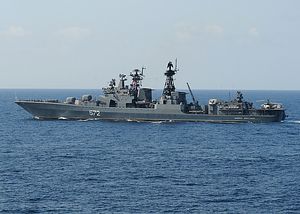This week, Russia’s Pacific Fleet will dispatch a number of surface warships to the South China Sea to participate in the annual Sino-Russian naval exercise, dubbed Joint Sea 2016, held from September 11 to 19, TASS news agency reports.
“At the beginning of September, a detachment consisting of the big anti-submarine ships Admiral Tributs and Admiral Vinogradov, the big amphibious ship Peresvet, the sea towboat Alatau, and the tanker Pechenga will head for Zhanjiang in China,” the chief press officer of the Eastern Military District for the Pacific Fleet, Captain Second Rank Vladimir Matveyev said.
The Admiral Tributs and Admiral Vinogradov are both 6,930-ton Project 1155 Udaloy I-class anti-submarine warfare destroyers originally built for the Soviet Navy. The destroyers also have anti-ship capabilities and carry the P-270 Moskit supersonic ramjet powered anti-ship missile (NATO reporting name: SS-N-22 Sunburn).
The Peresvet is a Project 775 Ropucha-class landing ship specifically designed for beach landings and capable of carrying a cargo of up to 450 tons. It can carry up to ten main battle tanks or 12 armored personnel carriers plus 230-340 troops. The ship features a bow and stern ramp for unloading vehicles and the presence of the Russian landing ship indicates that the naval exercise will likely include a simulated amphibious assault.
The Russian flotilla appears not to comprise any submarines. Given that Russia is in the process of delivering military hardware, including two frigates and six submarines, to Vietnam, Moscow is being careful to maintain its balancing act on the South China Sea maritime disputes between Beijing and Hanoi, which could be one reason why Russia’s detachment is relatively small and does not include of the Russian Navy’s newest warships.
While it has not been officially confirmed that the People’s Liberation Army Navy (PLAN) Nanhai (South Sea) Fleet will host the exercise—the PLAN’s North and East Sea Fleets hosted previous Sino-Russian naval drills—the fact that the Russian ships are heading to Zhanjiang, home to the headquarters for the South Sea Fleet, appears to confirm the central role that the fleet will play in the joint naval drill.
China and Russia have held six joint naval drills since 2005, with Beijing first assuming the role of host for the Joint Sea exercise in 2012. In 2015, both countries “held naval and amphibious assault exercises in the Sea of Japan, a smaller naval drill in the Mediterranean, among a number of other bilateral military exchanges. Both countries have also participated in trilateral, and multilateral exercises, for example, under the umbrella of the Shanghai Cooperation Organization (SCO),” I noted previously.
According to the Pentagon’s 2016 report on China’s military activities, last year the major Sino-Russian naval exercise consisted of two parts: “phase one in the Mediterranean focused on protecting sea lines of communications (SLOCs) and combating terrorism and phase two in the Sea of Japan featured simultaneous amphibious landings, joint air defense drills, and anti-surface ship drills.”
I explained elsewhere:
Given that China and Russia do not have a formal military alliance, the interaction between the two navies will be limited and cannot be compared to similar exercises held by NATO, particularly when it comes to practicing complex integrated military operations. The major rationale behind the joint drills will be political rather than practical and is meant to emphasize the burgeoning security partnership between the two countries.
China and Russia pledged in April to increase the number of joint military exercises in 2016 (See: “China and Russia to Increase Number of Military Exercises in 2016”).

































